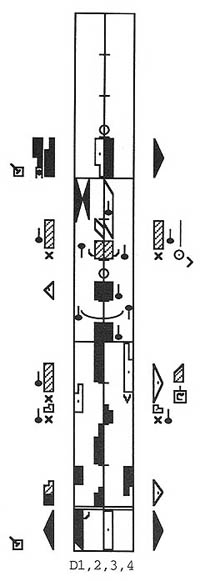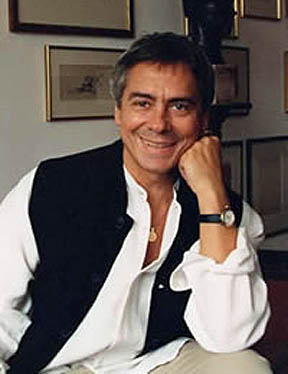CHAPTER 18
Tucson Civic Ballet
Comes To An End
It was soon time
for a return to my beloved Tucson for another spring production...
When I called for negotiations, in stunned
surprise I was presented with a sobering picture. While I was away
in New York, another dancer whom I had hired to dance and had
entrusted to rehearse the company in my absence, made it known to
the Board of Directors that he himself wanted to run the company.
Because he now had a school in Tucson, which largely through my help
and through his association with the company had supplied some
dancers, he was able to create a rallying-point. The Board
foolishly agreed. After all, they felt, why bring someone all the
way from New York when they had someone already in Tucson who could
do the job.
The Board consisted mainly of mothers, who
didn’t know much about ballet except that their daughters were in
it, and even less about choreography. They didn’t know for example,
that to be able to stage an authentic Swan Lake or Coppelia, took a
certain degree of know-how. In those days there were no videos of
these ballets that one could study and re-construct from. I did it
through Benesh notation and also having danced in them. My
replacement had none of these advantages. But he did have an imposing
figure and an ability to schmooz.
By hiring him to dance in Swan Lake, Coppelia
and Nutcracker, I had not completely thought it through. This
working at cross-purposes had a cost I should have taken into
account. How nice to be able to walk into an already built and
promising company and take it over. It was sabotage!
So I was no longer at Harkness, and now, after
seven years of building a company from scratch, I no longer had
Tucson. The bitter irony was that the Tucson Civic Ballet still
owed me over $6,000 which I had invested in its future. They had not
even taken that into account. It only underscored the extent of the
damage. What happened to all the professional scenery and costumes
that I had supplied was anybody’s guess. In three years time my
replacement had not only ruined all that I had built but also lost
the company to others. Eventually, after a long series of directors
and catastrophes it became the professional “Ballet Arizona”, based
in Phoenix. At least he benefited from the association
with a dancing school that grew to be one of the biggest in Tucson.
Transitions
I
always enjoyed doing the dancing/acting roles of Drosselmeyer and
Dr. Coppelius, after the classical, Princely roles had come to a
close for me, at least on a professional level. Of course I had
danced those roles in England and in Tucson because, well, there
was no one else to do them, but I never was a true
danseur noble. I always
envied other male dancers with stature and long elegant legs.
I wouldn’t say my height was exactly a
stumbling-block, but dancers in generations before me were small,
almost midget like. But by my time, choreographers were looking more
for the tall, blond, all-American types.
I was really born to be a character dancer and
felt more at home dancing a mazurka, a polonaise, a csardas. I had
always found that the movements of folk and character dance,
fortified by classical technique, helped achieve a greater
virtuosity, even nobility. In fact, all forms of theatrical dance,
in one measure or another, achieve a higher, more perfect level of
performance with the underpinning of classic ballet. Even skating
and gymnastics benefit by it.
I had started to be increasingly aware that
someday I would have to stop dancing professionally, and as any
dancer will tell you, this is a brutal fact to come to terms with.
Luckily, being a choreologist, I no longer had to attend dance
auditions that had been such a constant part of my early life, and
the life of every dancer who wants a stage career. The vigorous
element of competition, which continues and even increases as a
dancer contends with other dancers for jobs, gets more and more
arduous as he grows older. The constant, if unspoken competition is
wearisome. And all that, just for some minor triumph, like a job in
a musical show. It wasn’t that I didn’t know from the beginning the
characteristics of a choreologist’s job. I considered myself very
fortunate to be able to do it. Still, I was walking through the
world when I would rather had been dancing in it. I was up against a
dilemma.
Transition is an inevitable part of every
dancer’s life. Making a decision to stop dancing, or at least to
change directions is not easy.
So, what do dancers do when they cease dancing?
Teach? Choreograph? Or go into something completely different. I had
choreology. I could notate and do staging from notation, either from
my own or from that of someone else. And I could choreograph. This
could be my longevity strategy.
The Dance Notation Bureau
And Labanotation
The Dance Notation Bureau in New York seemed like a
good place to work. At least for a while. Although they promoted the
Labanotation system, which is completely different from Benesh, they
had just received a
 grant from the National Endowment For The Arts
to be able to also offer the services of a Benesh choreologist. In
doing that, choreographers would be given a choice as to which
system they wanted their works to be recorded in. It only seemed
fair. grant from the National Endowment For The Arts
to be able to also offer the services of a Benesh choreologist. In
doing that, choreographers would be given a choice as to which
system they wanted their works to be recorded in. It only seemed
fair.
Unlike the attitude back at the London
Institute, the Dance Notation Bureau was far more friendly to other
systems. At least they were willing to look at them. Labanotation is
a scrupulous system of symbols developed by Rudolph Von Laban, and
like Benesh, charts every movement on paper, effectively creating a
movement ‘score’. The Labanotation of Eugene Loring's "Billy the
Kid" in 1942, was the first ballet notated in the United States. It
came at the request of the choreographer, who wanted it to help
establish his ownership of the choreography.
While working at the
Dance Notation Bureau I
became a Certified Labanotation re-constructor. That meant I was now
bi-lingual, knowing two notation systems, and this was a unique
position to hold.
During my time at the Dance Notation Bureau I was sent to
Philadelphia to notate one of Ben Harkavy’s ballets, a ridiculous
work with impossible music. Harkavy was arrogant and rude and I
remembered him in the same classes at George Chaffee’s studio when I
first arrived in New York. His name then was Benjamin Goldfarb.
A more pleasant association was when I was sent
to Hartford, Connecticut to notate Balanchine’s “Allegro Brillante”
being set by Sarah Leland. That company was then run by Michael
Utoff.
Left: Excerpt from the Labanotated score of
Balanchine’s Symphonie Concertante
American Ballet Theater
American Ballet Theater was, and is the leading ballet company in
America. It was where all the real ballet stars were in what was
termed “the golden years”.
ABT is still the best company in America, with superb dancers and a
fantastic repertory. They had used choreology before, but only with
a guest choreologist coming from England now and then to stage a
work of Ashton, or Cranko. To be a resident choreologist for ABT
would be a hard nut to crack.
As luck would have it, John Neumeier was choreographing his ‘Hamlet’
for ABT and phoned the Dance Notation Bureau for a Benesh
choreologist. I of course was the one to be sent.
Neumeier, a brilliant young choreographer, gave Hamlet a modern,
dramatic framework and he had some of ABT’s hottest stars to dance
it. Misha Baryshnikov, Eric Bruhn, Gelsey Kirkland. This was full
star quality.
 For a month I sat in on every rehearsal, busily notating this ballet
with an impossible piano score by Aaron Copland. His ballet scores
for “Rodeo” and “Billy The Kid” are real Americana and certainly
danceable, but this “Connotations For Piano” was not only difficult
to listen to, it was nearly impossible to count. After one
performance, ABT pulled Hamlet from the repertory and Neumeier
returned to Germany, nearly broken hearted. I felt sorry for him,
but it really was an awful ballet. Later on he revised it for his
own company in Hamburg, Germany, using my notated score as an aid. I
hope it fared better there. For a month I sat in on every rehearsal, busily notating this ballet
with an impossible piano score by Aaron Copland. His ballet scores
for “Rodeo” and “Billy The Kid” are real Americana and certainly
danceable, but this “Connotations For Piano” was not only difficult
to listen to, it was nearly impossible to count. After one
performance, ABT pulled Hamlet from the repertory and Neumeier
returned to Germany, nearly broken hearted. I felt sorry for him,
but it really was an awful ballet. Later on he revised it for his
own company in Hamburg, Germany, using my notated score as an aid. I
hope it fared better there.
Photo: John Neumeier
All was not lost. Apparently the manager of ABT was pleased with my
work and I was called in to sign a contract as resident
choreologist. I would first be assisting the famous new defector
from the Soviet Union, Misha Baryshnikov on his first effort at
choreography, “The Nutcracker”. The Nut had finally been cracked!
|
|
|
|
Copyright ©2006-2021 OKAY Multimedia |
|
|